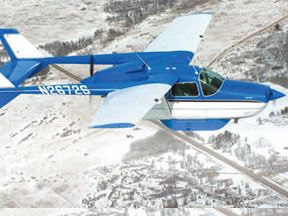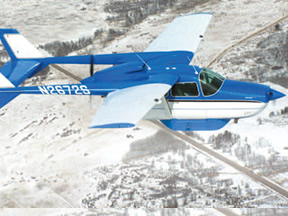
The idea of the push-pull twin makes such fundamental sense, that it has been applied to aircraft designs in one form or another for nearly 100 years and in literally dozens of models you’ve never even heard of. As recently as 2005, Adam Aircraft tried the idea again with the A500 push-pull piston twin. Like many before it, the airplane was gutted more by market reality than by a fundamental flaw in the idea.
Then there’s the Cessna 337, arguably the most commercially successful push-pull attempt, at least in terms of numbers built. And although the 337 Skymaster isn’t the most popular twin ever marketed, it’s done all right for itself and has achieved its primary goal: eliminating asymmetric thrust and simplifying the pilot’s workload in the event of an engine out.
If the concept was sound, the execution of it by Cessna was a little less so. The Skymaster acquired a reputation as a bit of maintenance hog and although its performance is respectable, other twins do just as well, if not better, on less fuel and on less dollars spent on wrenching. Like most used twins on the market today, Skymasters are a bargain. When fuel prices started their climb five years ago, market values of twins started downward and today, you can find a reasonably well-equipped Skymaster for we’ll under $100,000. Airframe values seem to have stabilized since we last examined them three years ago, which is more than we can say for other piston twins.
A SIMPLER WAY
When Cessna began to develop the Skymaster in the mid-1960s, the accident history was horrid for twins. Part of that was due to training. The doctrine in those days was to actually surprise the pilot with a real engine shutdown to simulate losing one. In the hairy-chested thinking of the day, instructors would even do this on takeoff. As a result, loss-of-control accidents due VMC rollovers were, if not common, more prevalent then they are today.
In an engine-out situation, conventional piston twins generally need to be handled with kid gloves lest the airplane get too slow and roll over on its back. So Cessna approached this problem just as other designers had going back to the Caproni Ca. 1 of 1914: they aligned the two engines with the airframe centerline, offering pilots the safety of a second engine without the penalty of adverse handling. If one quits, identify it, feather it and don’t worry about the dead-foot, dead-engine drill. The FAA even granted the 337 its own class rating, limiting pilots to centerline-thrust twins only. It was much easier—and probably safer—to earn a multi-engine rating in a Skymaster than in a conventional twin,
Part of Cessna’s plan worked, since there’s little question the Skymaster is easier to fly on a single engine than a conventional twin. But, since the VMC rollover accident doesn’t happen that often in the real world because training doctrine moved to zero thrust instead of an actual engine shutdown, the airplane’s overall accident record isn’t that much better than conventional twins.
A pilot looking to improve redundancy by stepping up from a single to a twin certainly will achieve it with a Skymaster. But in the bargain of gaining redundancy, pilots can be forced to accept a platform with more cabin noise, a set of operating peculiarities all its own and tightly packaged systems presenting more of a challenge to maintenance personnel than if each engine resided on its own wing. All of this might argue in favor of a single-engine airplane or even a conventional twin. Then again, if you fly over the Great Lakes at night, maybe not.

313
MODEL HISTORY
The 337 Skymaster’s front/rear engine layout and high wing started out as the fixed-gear Model 336 in 1964, powered by Continental IO-360-A engines of 195 HP apiece. Widely acknowledged as a slug, Cessna sold only 195 336s in one year of production; 77 remain on the FAA’s registry today. In 1965, the company folded the gear and upgraded powerplants to a pair of Continental IO-360-Cs pumping out 210 HP, resulting in the 337 Skymaster. Cessna sold 239 copies that year. (Not really learning from its 336 experience, Cessna flew a cantilever-winged, lower-powered version, the 327, in late 1967, but it proved too slow and the project was dropped the next year.)
To make the original 336 a retractable, Cessna borrowed the complex and occasionally troublesome hydraulic landing gear system from the 210. In 1973, it was upgraded to a simpler and more reliable electro-hydraulic system. While less complex and easier to maintain, the system still isn’t as robust as, say, a Baron’s or Seneca’s.
Early models also came with multiple fuel tanks, another system that proved problematic in the field. It, too, was replaced in 1973 by a superior, less complicated system. A turbocharged version—the T-337B, powered by 210-HP TSIO-360-A or -B engines from Continental—appeared in 1967, but was dropped in 1972 with the addition to the Skymaster line of the almost-revolutionary pressurized 337 version, the T-337 G-P, powered by TSIO-360-C engines up-rated to 225 HP.
The turbo reappeared in 1978, with TSIO-360-H powerplants, but Skymaster sales had begun slipping by then. Cessna pulled the plug following the 1980 model year, after a total production run of 2058, plus 332 pressurized versions. In addition, Cessna built slightly more than 500 Skymasters for the U.S. Air Force. These saw extensive action in Vietnam as the O-2A. This version boasts structural
beefups, hard points and extra windows. These airplanes frequently appear on the used market and may we’ll be the least expensive warbirds available. Additionally, some civilian models were converted to an O-2B configuration for the military to use in psychological warfare.
Major tweaks in the airplane’s history were few, but there were many designation changes. Beginning in 1970, some inspection panels were added—making maintenance easier—and the airframe was lightened a bit, increasing useful load. The interior arrangement also changed through the years, with various combinations of seat mounting.
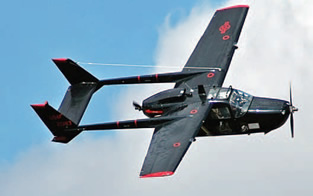
313
As is common with any aircraft, the non-pressurized 337’s gross weight crept up during its years in production. Early models started at around 4200 pounds; late ones weighed 4630 pounds, with max landing weight limited to 4400 pounds. Meanwhile, the P-337, with its 30 extra horsepower, had a takeoff weight of 4700 pounds and max landing weight of 4465 pounds.
Piston-twin prices are as soft as ever, and the 337 is no exception. On the up side, most of the depreciation has been squeezed out of these airframes. The downside? Cessna 337s can’t be counted on to increase much in value. But a Skymaster is a lot of airplane for the money. Besides current fuel prices and future uncertainties, other factors depressing prices are that the 337 has a reputation for being a maintenance hog—one that’s not entirely deserved—and they aren’t all that fast as like-powered twins go.
Buyers should be aware, however, that buying a cheap twin is not the same as operating a twin cheaply. A hangar queen will eat through a bunch of money if it needs remedial work and, in any case, you’ll need to find a shop familiar with the breed to do the pre-buy and maintain the airplane going forward. The Skymaster doesn’t perform much better than a Cessna 210, and it has two of everything to maintain and replace, driving up ownership costs.
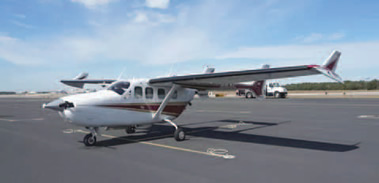
379
PERFORMANCE, HANDLING
Skymasters aren’t speed-demons, although the turbocharged models do respectably we’ll for pilots willing to take them into the teens. Owners of normally aspirated models can plan on between 155 and 165 knots true, depending on altitude and how much fuel they want to burn. The turbocharged and pressurized models will push 190 to 200 knots at 20,000 feet, their maximum certified altitude. At middle altitudes, 170 to 180 knots is typical for the turbo models, which ain’t bad.
Since Skymasters have relatively small displacement six-cylinder engines, fuel burn tends to be reasonable, ranging from 15 GPH to 22 GPH total, with 19 to 20 GPH typical for a 150- to 160-knot cruise. For comparison, a Twin Comanche will do about the same speed on 100 fewer horsepower and a lot less gas. Efficiency isn’t a Skymaster hallmark, except when compared to larger, faster twins.
All-engine rate of climb ranges from a modest 1300 FPM in the old 336 to a lethargic 940 FPM with the last 337H models. We’re unaware of any other twin-engine airplane with a book rate of climb below 1000 FPM; even the old 150-HP Apache had a book climb of 1250 FPM with both engines running. On the other hand, lose an engine in a 210 and there’s no rate of climb, only a rate of descent. In a 337, you should at least be able to eke out 200-300 FPM.
Like many Cessnas, runway performance is good. Landing-configuration stall speeds range from 55 to 62 knots, depending on the gross weight of the particular model—about 10 knots below conventional twins like the 310.
As a result, a Skymaster will get off the ground in less than 1000 feet at gross weight—a feat very few other twins can manage. Barrier performance is not quite as good, however; the leisurely climb rate brings the Skymaster’s 50-foot takeoff figures down to the middle of the light-twin pack.
The single-engine climb rates of all the light twins tend to be very similar—200 to 300 FPM—because engine-out climb rate is a certification point around which the airplane is designed. The FAA requires a certain minimum climb, figured by a formula relating to stall speed, and the manufacturers typically bump up the gross weight to the point at which the airplane just barely meets the FAA minimum. Any excess engine-out climb capability is, in effect, wasted payload. And payload numbers sell airplanes.
What’s surprising is the difference between the front and rear engines. Climb on the front engine only is about 50 FPM less than on the rear, but not necessarily for all versions of the Skymaster. Reader Robert Prader told us his research reveals that later models have better front-engine performance. “It is true that front and rear engine single-engine climb rates are significantly different for all pre-1973 Skymaster models; however, the front and rear single-engine climb rates are not significantly different for the pressurized models and the 1978 and later turbo models,” he said. “If you consult the POH for any pressurized model, you will find that a single-engine climb rate of 375 FPM is listed for a standard day at sea level at gross weight, with no mention of which engine is out. If you consult the POH for the 1980 non-pressurized turbo model, you will find it specifies a climb rate of 335 FPM for the same conditions, again with no mention of which engine is out.”
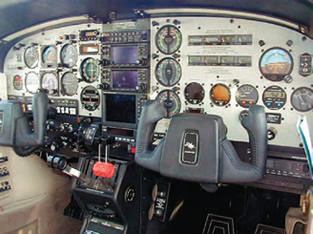
While leaving the gear down produces a climb penalty of a bit over 100 FPM, raising it carries a temporary 240 FPM hit. (Praeder told us this is about average for most twins and probably for single-engine retracts as well.) This is because Cessna’s complicated gear door arrangement adds drag while the gear’s in transit. In an after-takeoff engine-out situation, it may be better to leave the gear down, just as it is recommended in some singles to leave it down until obstacles are cleared.
In normal flight, the Skymaster has typical Cessna handling: heavy in pitch, reasonably responsive ailerons. (The P-model has especially light ailerons.) Pilots praise its IFR stability.
The noteworthy aspect of the Skymaster’s handling—indeed, the whole reason for the airplane’s existence—shows up when an engine fails. Instead of the normal yaw-roll-stall-spin scenario too often following engine failure in “conventional” twins, the Skymaster continues to fly straight ahead. An unprepared or rusty pilot can take his time and concentrate on the task of identifying and feathering the prop on the failed engine, without worrying about losing control.
PAYLOAD, RANGE
A Cessna press release from the 1970s describes the Skymaster as “a full six-place airplane with nearly a ton of useful load.”
Good luck with that. At best, the two rear seats can accommodate youngsters. And that press release conveniently forgot when the fifth and sixth seats are installed, there’s no baggage space, nor is there a baggage door. Consider the Skymaster a roomy four-placer.
Real-world useful loads run around 1500 pounds—not bad at all, and several hundred pounds more than a Twin Comanche. Standard fuel is 93 gallons, which should leave more than 900 pounds available for payload; plenty for four passengers and their bags. Standard fuel is just adequate, however—unless you throttle back—providing a bit more than three hours with IFR reserves at fast cruise.
Pre-1973 airplanes with long-range tanks had a four-tank fuel system; later ones came with a two-tank system. The long-range tanks—150 gallons in 1975 to 1980 models, 131 gallons in earlier models—solve endurance limitations nicely, at the expense of payload, of course. One owner told us that with long-range tanks full, he has seven-plus hours at 150 knots with 650 pounds of payload (three people and bags). Not a bad compromise.
Oddly, the P-337 is allowed only five people; it was certified under different rules requiring an emergency exit in a six-seat airplane. Rather than put in the exit, Cessna simply limited the seating to five. Early P models had a middle seat hinged up and to the side to get at the back row, but these seats didn’t slide fore and aft. Access to the rear seats in other Skymasters requires an awkward scramble over the center row.
The Skymaster’s visibility is excellent—about as good as it gets in any light airplane, single or twin. The view down is unlimited, of course, and the wing’s leading edge is back far enough that it doesn’t block upward vision, either, as with most Cessna singles. Good visibility is not only a safety feature; it adds to the feeling of roominess in the cockpit.
The Skymaster is also quite noisy, since the passengers are sandwiched between the engines. Also, sympathetic vibration can be a problem, particularly without prop synchronizers. Conventional twins are quieter by far.
MAINTENANCE
The Skymaster was the most complex aircraft ever engineered and manufactured by Cessna’s Pawnee Division, which otherwise built only Cessna singles. Evidence suggests the division simply wasn’t up to the task, particularly in the 1975-to-1980 period when production was growing rapidly and Cessna was plagued by an epidemic of design, engineering and production problems.
For example, the pressurized Skymaster was initially such a disaster that the first year’s production was recalled to the factory for complete remanufacture and modification. Distinct from other twins, Cessna had to pack everything into the fuselage, not having the luxury of sticking systems out in the wings or into the nose. As a result, access is difficult and it is those systems where most maintenance problems will be found.
The basic airframe is stout, with a rugged strut-braced wing. There are remarkably few ADs on the airplane. And remember that the military version of the Skymaster did plenty of rough duty in Vietnam, often flying home with bullet holes or worse.
Still, a potential Skymaster nightmare is runaway maintenance costs, particularly in the turbo and pressurized models, so the prudent purchaser will closely examine logbooks and service records of any aircraft under consideration.
MODS, GROUPS
The Riley Rocket was a popular Skymaster mod and included upgrades to 310-HP TSIO-520 engines, intercoolers, three-blade props and air conditioning. Rockets come on the market now and again, at a premium price over stock models. For more, check out www.skymaster.com. What appears to be a follow-on to that product is available from www.therocket2.com. This company offers full refurb services on the Skymaster line.
Other mods include vortex generators from Micro Aerodynamics (www.microaero.com) and intercoolers from American Aviation (www.americanaviationinc.com). Both Horton (www.hortonstackdoor.com/stolcraft_description.htm) and Sierra Industries (www.sijet.com) apparently still offer STOL kits and other aerodynamic mods. A wing spoiler kit is available from PowerPac Spoilers (www.powerpacspoilers.com).
Aviation Enterprises (www.cessnaskymaster.com) offers a wide range of major modifications for Skymasters, ranging from air conditioning, airstair doors, extended wingtips, IO-550 engine conversions—for one or both engines—long-range fuel and MT propellers. The company also can provide various parts, including cargo pods. Similarly, RT Aerospace (www.rtaerospace.com) offers several items of interest to the Skymaster owner, including a convertible rear seat for the baggage area.
Cessnas seem generally blessed with good owner organizations, perhaps because the company abandoned the piston market in 1986 and stayed out of it until 1997. The clubs and groups have proven to be as good as it gets when it comes to support.
Every Cessna owner should join the Cessna Pilots Association (www.cessna.org). The organization offers the usual benefits, including an insurance program, monthly newsletter and fly-ins, and has a wealth of Skymaster-specific information. Two useful if unofficial Skymaster Web sites are the Cessna Skymaster Web Site (www.skymaster.org.uk) and SOAP, Skymaster Owners And Pilots (www.337skymaster.com).
Reader Comments
My aircraft is a 1965 Cessna 337. She is based at Linden, New Jersey. I have owned her for about a year and a half. At the time of purchase, the aircraft had no significant upgrades. All instrumentation was original. There were two old navcomms, a DME, a LORAN and an ADF.
Last summer, I pulled out the number 2 navcomm, the ADF, DME and LORAN. I installed an Aspen EFD1000 Pro PFD and a Garmin GTN750. Planned upgrades, in probable order of priority, are a JPI primary engine monitor, an autopilot and maybe a GTN650. ADS-B In is also in the cards.
When I first bought her, I had no experience with twins. My primary training was entirely in Cherokees, Archers and a Diamond DA20. After that came a flying club with Cessna 172s and the Civil Air Patrol (more 172s and some 182s). That was my intro to the high-wing world.
I never thought of buying a twin. I came close to buying a Comanche, but the price was too high. This Skymaster happened to be based at Linden, where my flying club was. The owner’s mechanic was on the field, too. When the owner decided to sell, his price was right: $50,000 got me a flyable airplane with a pair of mid-time Continental IO-360s. The airframe was relatively low-time, as the previous two owners flew infrequently, flew VFR only and rarely went cross-country.
For the missions I envisioned, this is an excellent airplane. It has the range and is comfortable enough for trips from my home base to Montreal, Chicago, Nashville and other destinations. It is big, heavy and stable, and it makes a good IFR platform.
Some of the numbers: I cruise at 9 to 10 GPH per engine doing 155 knots.
Fuel capacity is 128 gallons in two mains (92 gallons total) and two aux (36 gallons total) tanks.
My annual (only had one so far) cost about $1200. Insurance last year cost $2700 and should be less now that I have about 75 hours in type. Flying the 337 is a real pleasure. At 4200 pounds max gross, she feels quite stable in most conditions. She does handle more like a truck than a sports car, but that’s not a problem for an aircraft having the range and capacity that this one does.
There are some operational considerations to be aware of when flying the 337 as opposed to a conventional twin. Instead of raising the gear at positive rate of climb, you wait until obstacles are cleared. The gear doors are closed when the gear is down and when the gear is open. The doors open while the wheels are in transit. Accordingly, there is far more drag while the gear is in transit than when the gear is down. If you lose hydraulics while raising the gear, you could be low, slow, at a high angle of attack and with far more drag diminishing your rate of climb than if you left the wheels out until you cleared your obstacles.
On the takeoff roll, you must advance the rear engine throttle first, make certain you are developing power and only then advance the front-engine throttle. In the event of an in-flight engine failure requiring shutdown and feathering of the prop, you must be very careful to identify the correct engine. Given the push-pull configuration, “dead foot/dead engine” does not work.
On the positive side, on short final you can play with the throttles differentially to get an aggressive sink rate if needed, without worrying about asymmetric thrust or adverse yaw.
One of the neat features of the 337 is the great visibility. In a 172 or 182, your visibility upward to the sides is limited because of where the wing is. The left wing is right there next to your head. This limits your ability to see traffic at 9 o’clock or 3 o’clock high, and limits your view as you are making turns in a traffic pattern.
You don’t have those problems with the 337 because—as in a jet—the wing is behind you. Given how the weight of the two engines is distributed, the center of gravity and the center of lift are behind the pilot’s station. With the wing behind you, your visibility is unrestricted.
Roger Levy
Linden, New Jersey
I am writing to call attention to some statements that I believe were either not accurate, or not fully accurate, in the discussion of climb rate and single engine performance in your previous report on the Skymaster, including the following passage.
“What’s surprising is the difference between the front and rear engines. Climb on the front engine only is about 50 FPM less than on the rear.” It is true that front and rear engine single-engine climb rates are significantly different for all pre-1973 Skymaster models; however, the front and rear single-engine climb rates are not significantly different for the pressurized models and the 1978 and later turbo models.
If you consult the POH for any pressurized model, you will find that a single-engine climb rate of 375 FPM is listed for a standard day at sea level at gross weight, with no mention of which engine is out. If you consult the POH for the 1980 non-pressurized turbo model, you will find it specifies a climb rate of 335 FPM for the same conditions, again with no mention of which engine is out.
Aerodynamic refinements on 1973 and later models, including switching from 76-inch props front and rear, to a 78-inch prop in front and a 76-inch prop in the rear, reduced the difference between the front and rear-engine climb rates on normally aspirated models, and essentially eliminated them on the pressurized and non-pressurized turbo models. At 10,000 feet ISA and gross, the SERCs are still a respectable 245 and 210 FPM for the pressurized and 1980 turbo models, respectively.
As for the leaving the gear down versus raising it, according to my research, the drag during Skymaster gear retraction is about average for a light or medium twin; however, the drag is much below average when the gear is fully extended
Very few light- and medium-twin POH’s contain data on how many FPM will be lost from single engine climb rates when the landing gear is extended instead of retracted. Listed below is all of the data on the impact of gear extension on single engine climb rates that I was able to find in the light- or medium-twin pilot’s manuals on my bookshelf. The single-engine climb rates quoted are for sea level ISA at gross weight. In each case the gear-down climb penalty information was listed on the SERC performance chart.
Robert Praeder
Via e-mail

